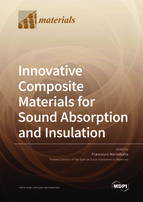Innovative Composite Materials for Sound Absorption and Insulation
A special issue of Materials (ISSN 1996-1944). This special issue belongs to the section "Advanced Composites".
Deadline for manuscript submissions: closed (31 December 2020) | Viewed by 39998
Special Issue Editor
Interests: hermal comfort; indoor environment quality; architectural acoustics; building simulation; energy saving and renewable energies
Special Issues, Collections and Topics in MDPI journals
Special Issue Information
Dear Colleagues,
In recent years we have observed a growing interest in sound absorption and sound insulation as a consequence of the ever-increasing awareness of the adverse effects that noise and lack of acoustic comfort may have on human health. Such an interest consequently stimulated researchers (and industry) to propose new materials with improved characteristics. For sound absorbing materials it is important to combine a sufficiently wide frequency range of action, with reduced mass and thickness, as well as with aesthetic requirements (due to the need to use such materials in spaces like classrooms, restaurants, train stations, etc.), not to mention durability and ease of maintenance. For sound insulating materials aesthetic problems are typically not an issue, but other aspects, such as balancing low dynamic stiffness with load bearing properties, become important in order to ensure the best performance. In addition, whatever the purpose, such devices should be sustainable, have a low impact in terms of life cycle assessment, and possibly involve the use of recycled materials or natural products. All of the above questions clearly represent a challenge for researchers, but at the same time they offer new opportunities to experiment with cutting-edge solutions, like those based on the use of composite materials, also including nanotechnologies, “green” vegetal and animal fibers, metal/ceramic/polymer matrixes, or even the more “advanced” acoustic metamaterials. At the same time, new, or updated, mathematical models and simulation tools will be needed to explain and predict the acoustic behavior of such composite materials.
This Special Issue provides an excellent opportunity for those who are studying and working within this continuously evolving field. Research articles, review articles and communications relating to theory, simulation, fabrication, properties characterization and applications of sound-absorbing and sound-insulating composite materials are all invited for this Special Issue.
Prof. Francesco Martellotta
Guest Editor
Manuscript Submission Information
Manuscripts should be submitted online at www.mdpi.com by registering and logging in to this website. Once you are registered, click here to go to the submission form. Manuscripts can be submitted until the deadline. All submissions that pass pre-check are peer-reviewed. Accepted papers will be published continuously in the journal (as soon as accepted) and will be listed together on the special issue website. Research articles, review articles as well as short communications are invited. For planned papers, a title and short abstract (about 100 words) can be sent to the Editorial Office for announcement on this website.
Submitted manuscripts should not have been published previously, nor be under consideration for publication elsewhere (except conference proceedings papers). All manuscripts are thoroughly refereed through a single-blind peer-review process. A guide for authors and other relevant information for submission of manuscripts is available on the Instructions for Authors page. Materials is an international peer-reviewed open access semimonthly journal published by MDPI.
Please visit the Instructions for Authors page before submitting a manuscript. The Article Processing Charge (APC) for publication in this open access journal is 2600 CHF (Swiss Francs). Submitted papers should be well formatted and use good English. Authors may use MDPI's English editing service prior to publication or during author revisions.
Keywords
- Sound-absorbing materials
- Sound-insulating materials
- Composite materials
- Sustainable and green materials







